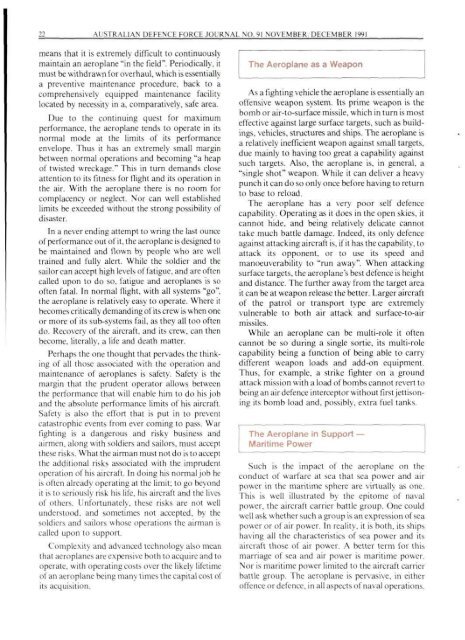ISSUE 91 : Nov/Dec - 1991 - Australian Defence Force Journal
ISSUE 91 : Nov/Dec - 1991 - Australian Defence Force Journal
ISSUE 91 : Nov/Dec - 1991 - Australian Defence Force Journal
Create successful ePaper yourself
Turn your PDF publications into a flip-book with our unique Google optimized e-Paper software.
22 AUSTRALIAN DEFENCE FORCE JOURNAL NO <strong>91</strong> NOVEMBER DECEMBER 19<strong>91</strong><br />
means that it is extremely difficult to continuously<br />
maintain an aeroplane "in the field" Periodically, it<br />
must be withdrawn for overhaul, which is essentially<br />
a preventive maintenance procedure, back to a<br />
comprehensively equipped maintenance facility<br />
located by necessity in a, comparatively, safe area.<br />
Due to the continuing quest for maximum<br />
performance, the aeroplane tends to operate in its<br />
normal mode at the limits of its performance<br />
envelope. Thus it has an extremely small margin<br />
between normal operations and becoming "a heap<br />
of twisted wreckage." This in turn demands close<br />
attention to its fitness for (light and its operation in<br />
the air. With the aeroplane there is no room for<br />
complacency or neglect. Nor can well established<br />
limits be exceeded without the strong possibility of<br />
disaster.<br />
In a never ending attempt to wring the last ounce<br />
of performance out of it, the aeroplane is designed to<br />
be maintained and flown by people who are well<br />
trained and fully alert. While the soldier and the<br />
sailor can accept high levels of fatigue, and are often<br />
called upon to do so, fatigue and aeroplanes is so<br />
often fatal. In normal flight, with all systems "go",<br />
the aeroplane is relatively easy to operate. Where it<br />
becomes critically demanding of its crew is when one<br />
or more of its sub-systems fail, as they all too often<br />
do. Recovery of the aircraft, and its crew, can then<br />
become, literally, a life and death matter.<br />
Perhaps the one thought that pervades the thinking<br />
of all those associated with the operation and<br />
maintenance of aeroplanes is safety. Safety is the<br />
margin that the prudent operator allows between<br />
the performance that will enable him to do his job<br />
and the absolute performance limits of his aircraft.<br />
Safety is also the effort that is put in to prevent<br />
catastrophic events from ever coming to pass. War<br />
lighting is a dangerous and risky business and<br />
airmen, along with soldiers and sailors, must accept<br />
these risks. What the airman must not do is to accept<br />
the additional risks associated with the imprudent<br />
operation of his aircraft. In doing his normal job he<br />
is often already operating at the limit; to go beyond<br />
it is to seriously risk his life, his aircraft and the lives<br />
of others. Unfortunately, these risks are not well<br />
understood, and sometimes not accepted, by the<br />
soldiers and sailors whose operations the airman is<br />
called upon to support.<br />
Complexity and advanced technology also mean<br />
that aeroplanes are expensive both to acquire and to<br />
operate, with operating costs over the likely lifetime<br />
of an aeroplane being many times the capital cost of<br />
its acquisition.<br />
The Aeroplane as a Weapon<br />
As a fighting vehicle the aeroplane is essentially an<br />
offensive weapon system. Its prime weapon is the<br />
bomb or air-to-surface missile, w hich in turn is most<br />
effective against large surface targets, such as buildings,<br />
vehicles, structures and ships. The aeroplane is<br />
a relatively inefficient weapon against small targets,<br />
due mainly to having too great a capability against<br />
such targets. Also, the aeroplane is, in general, a<br />
"single shot" weapon. While it can deliver a heavy<br />
punch it can do so only once before having to return<br />
to base to reload.<br />
The aeroplane has a very poor self defence<br />
capability. Operating as it does in the open skies, it<br />
cannot hide, and being relatively delicate cannot<br />
take much battle damage. Indeed, its only defence<br />
against attacking aircraft is, if it has the capability, to<br />
attack its opponent, or to use its speed and<br />
manoeuverability to "run away" When attacking<br />
surface targets, the aeroplane's best defence is height<br />
and distance. The further away from the target area<br />
it can be at weapon release the better. Larger aircraft<br />
of the patrol or transport type are extremely<br />
vulnerable to both air attack and surface-to-air<br />
missiles.<br />
While an aeroplane can be multi-role it often<br />
cannot be so during a single sortie, its multi-role<br />
capability being a function of being able to carry<br />
different weapon loads and add-on equipment.<br />
Thus, for example, a strike fighter on a ground<br />
attack mission with a load of bombs cannot revert to<br />
being an air defence interceptor w ithout first jettisoning<br />
its bomb load and, possibly, extra fuel tanks.<br />
The Aeroplane in Support —<br />
Maritime Power<br />
Such is the impact of the aeroplane on the<br />
conduct of warfare at sea that sea power and air<br />
power in the maritime sphere are virtually as one.<br />
This is well illustrated by the epitome of naval<br />
power, the aircraft carrier battle group. One could<br />
well ask whether such a group is an expression of sea<br />
power or of air power. In reality, it is both, its ships<br />
having all the characteristics of sea power and its<br />
aircraft those of air power. A better term for this<br />
marriage of sea and air power is maritime power.<br />
Nor is maritime power limited to the aircraft carrier<br />
battle group. The aeroplane is pervasive, in either<br />
offence or defence, in all aspects of naval operations.

















